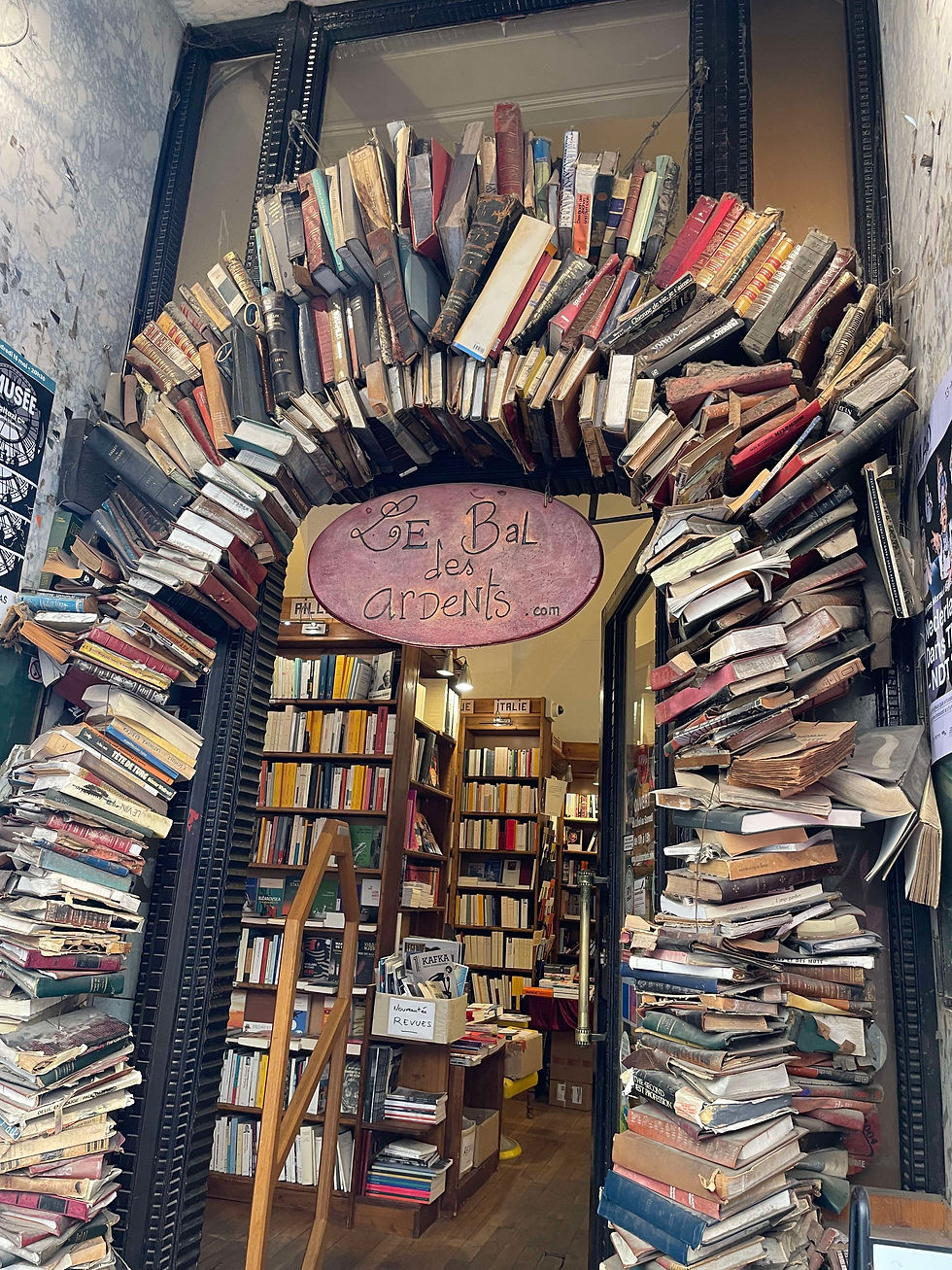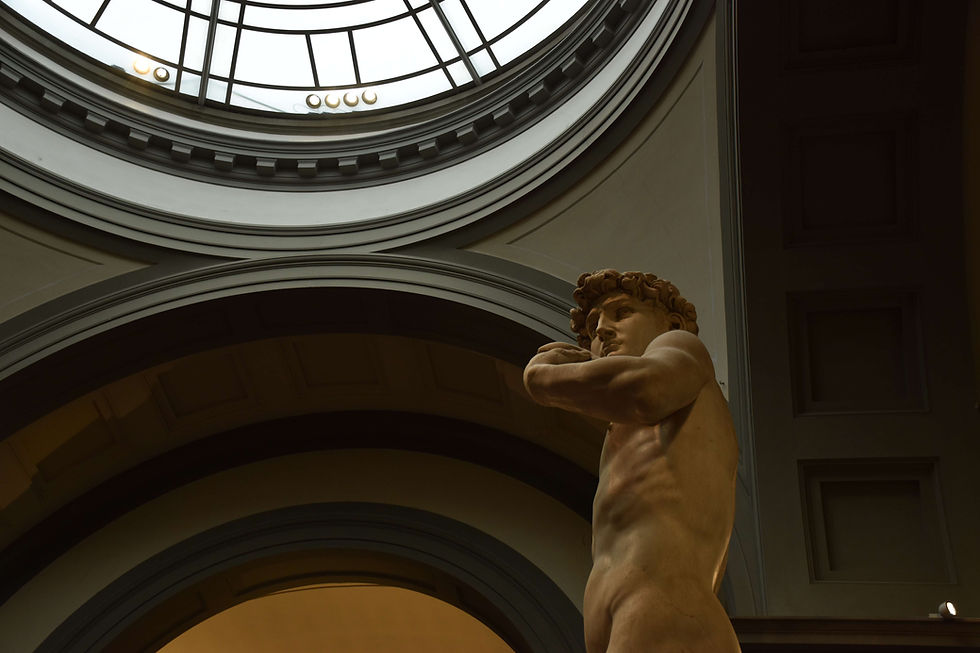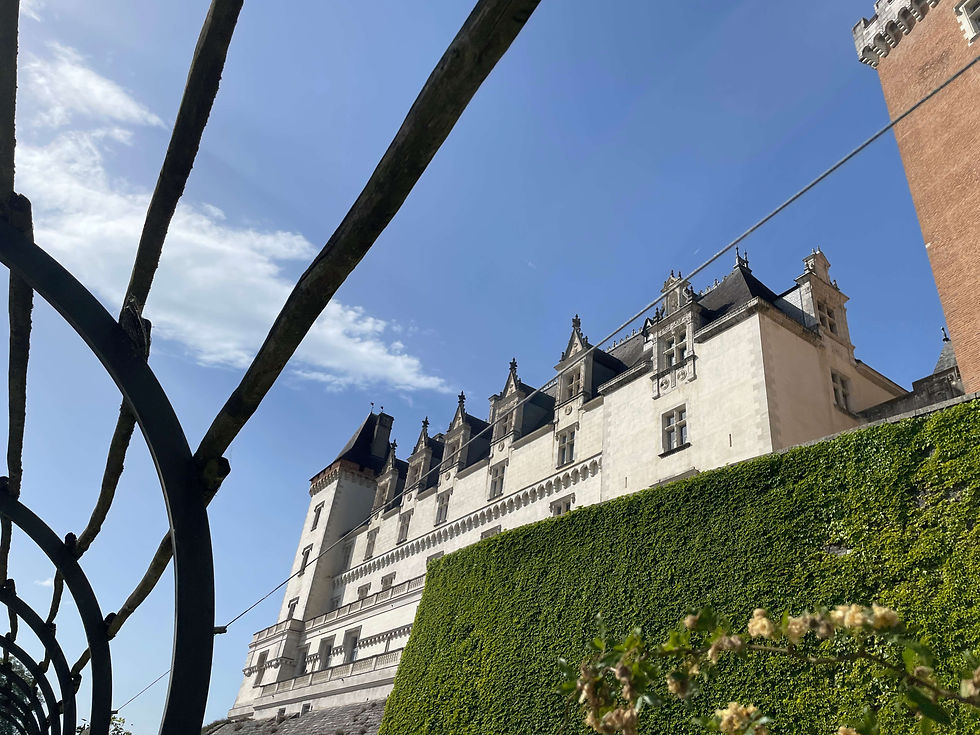The Linguistic and Literary Patrimony of Lyon
- Autumn Mayer
- Feb 27
- 5 min read
Updated: Mar 20
An Essay from Travel Writing
Lyon, France, has always been a city of language and literature. Though it earned its status as a UNESCO City of Literature in 2023, its history of language extends back at least as far as the Roman Empire. The lingering traces of Roman civilization still visible in Lyon today act as subtle reminders of this linguistic patrimony.
The ruins of the Théâtre Gallo-Romain, situated on the hill of Fourvière, comprise the grandest of these reminders. The ruins were once the oldest amphitheater in Roman Gaul, as well as one of the biggest at 108 meters in diameter and 10,000 seats. The first time I saw the ruins of the Théâtre Gallo-Romain, it was from the rain-slicked garden path above. I was coming down from the Basilica of Notre-Dame de Fourvière, one of the city’s other well-known monuments. The basilica’s grandeur still fresh in my mind, I looked down upon old stone walls that retained only half their original height and stairs that led to nothing. Arching benches backed into the hill in steady, empty rows. I was seeing a ghost, mist-shrouded and gray.
I returned on a sunny day and this time descended to the ruins. I found myself at the center of a two thousand-year-old architectural marvel: the lingering mark of Lugdunum’s center, the vestiges of Lyon’s history before France was France. The light shone hazy and diffused through air thick with the present-day city’s pollution—lingering smoke from a factory fire, I had heard. Once again, the farthest reaches of those old stones were cloaked, as though by time.

I imagined those stair-like benches full to bursting: the roaring of crowds, togas flapping in the wind, as below gladiators fight or an unfortunate Christian is devoured by lions. This image is so stereotypical1 it made me wonder about storytelling. I had previously known, from a Latin class I took as a junior in college, that a large portion of the Roman populace was literate; there’s evidence of foreign soldiers learning written and spoken Latin in the army. Did the average Roman ever write stories? What was the role of language in Roman society, specifically in conquered Gaul? Did those old stones, back when they were full of lively crowds, ring with the sound of many tongues?
After wandering through the ruins themselves, I had a brief opportunity to browse the ground floor of the Lugdunum Musée, which featured a special exhibit, “Un Empire, des peuples.” The exhibit explored, through the lives of six real people, how Rome was able to maintain its power in an “immense and plural territory.” This ability came partially from Rome’s tolerance. The colonized Gauls were allowed to continue practicing their own culture and religion, as long as they respected Rome’s culture and religion in return. Cultural tolerance resulted in cultural—and linguistic—intermixing. As I left the museum, I had even more questions than I entered with, so I was inspired to do some of my own research.
In the Gaulish region—which is now modern-day France, Belgium, and Luxembourg, as well as parts of Switzerland, the Netherlands, Germany, and Italy—Gaulish was spoken, along with other dialects and related languages. Texts were first written in the Greek alphabet and an Old Italic script from northern Italy. The shift to the Latin alphabet occurred, predictably, after the Roman conquest. The Gaulish elite chose to adopt Latin as a way to maintain their power, resulting in trilingualism as early as the 1st century B.C., so there would have been an intermingling of languages back when the amphitheater was in use. Then the Roman Empire fell in 476 A.D. Classical Latin began to evolve into Vulgar Latin, and Gaulish was replaced by Vulgar Latin and various Germanic languages brought by the new Frankish ruling class. Gaulish is thought to have gone extinct during the 6th century because working class Gauls and the Franks took up Latin, the prestige language of the Gaulish elite.
A few days after the ruins inspired my linguistic exploration of Lyon, I happened to spend a Saturday morning browsing the Musée de l’Imprimerie2, which illuminated the second half of Lyon’s literary history. Located a couple of blocks north of the Cordeliers métro station on the Presqu’île, the museum was once Lyon’s Hôtel de Ville. The peach-painted building was constructed in the 15th century and forms part of a traboule that links Rue de la Poulaillerie with Rue des Forces. It became the Musée de l’Imprimerie in 1956. The courtyard plaque is a copy of Emperor Claudius’s 48 A.D. speech advocating for the inclusion of the Gauls in the Roman senate; the original tablet, fittingly, is in the Lugdunum Musée. I entered the courtyard, passed the plaque, and wandered a ways up the traboule before I realized I’d missed the museum’s entrance. I circled back under arched tunnels, past apartments and groups of chatting people, and eventually found the door.
The first floor’s exhibit focuses on the history of printing, from the invention of woodblock printing in 3rd century China3 to the wider dissemination of information made possible by Gutenberg’s printing press. Walking through the exhibit, I could see evidence of how Latin became French slowly over time, integrating influences from Gaulish, Frankish, and Norman. The earliest evidence of French writing is from the 9th century A.D., and sure enough, the exhibit transitioned from Latin into recognizable French as the dates progressed. Johannes Gutenberg perfected the printing press, with metal moveable type, by 1450, making commercial printing possible on a large scale. The museum had a page of his Gutenberg Bible of display. The printing industry came to Lyon in 1472, and as a result Lyon became the European Printing Capital by 1550. King François I then declared French the official language of the Kingdom of France in the 16th century.
While the Roman Empire is long dead and Lyon is no longer the Printing Capital, Lyon is still a vibrant link between the Latin of Gaul’s conquering Romans and the many languages we are able to print and disseminate today. In a way, as I learn French while living in this City of Literature, I daily become a part of this rich linguistic history. Even after I’ve gone, the ruins of the Théâtre Gallo-Romain will continue to sit with eternal patience, a reminder of the beginning of Lyon’s linguistic patrimony to those who know how to look for it.
And to the point of being stereotypical, it likely wouldn’t have been lions. Bulls, wolves, and other animals native to the region would have been used instead.
Or, in English, the Museum of Printing and Graphic Communication
Bi Sheng (970–1051 A.D.) invented clay moveable type, and Wang Chen created a revolving table to make typesetting more efficient.
Works Cited
A Brief History Of Printing, The First Ever Printing Press & Introduction To England |
https://www.instantprint.co.uk/printspiration/be-inspired/the-evolution-of-print. Accessed 3 Feb. 2025.
secrets/a-speech-for
-eternity. Accessed 25 Feb. 2025.
Gaulish Language. https://encyclopedia.pub/entry/37432. Scholarly Community
Encyclopedia, Accessed 29 Jan. 2025.
“Lyon.” Citiesofliterature, https://www.citiesoflit.com/lyon. Accessed 25 Feb. 2025.
https://lugdunum.grandlyon.com/fr/un-musee-de-sites/theatres-romains. Accessed 25 Feb. 2025.
“The Printers.” MHL Gadagne.
GadagneThemedSheet16th-ThePrinters.pdf. Accessed 25 Feb. 2025.
-empire-des-peuples. Accessed 3 Feb. 2025.
.jpg)








Comments